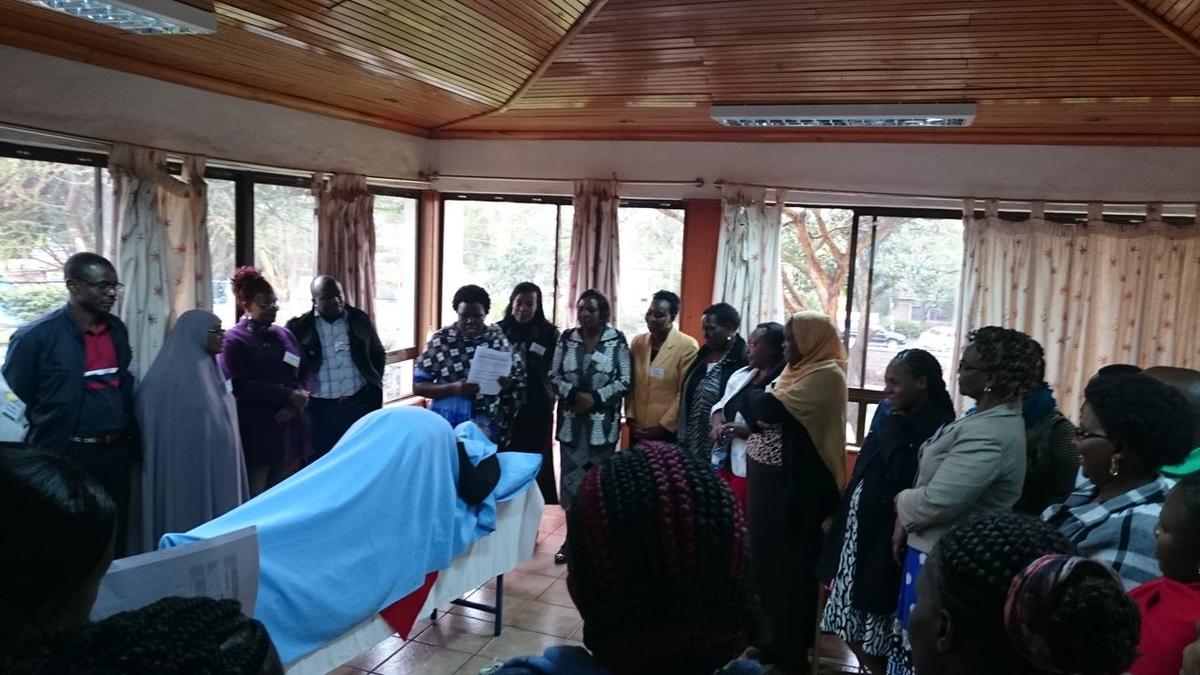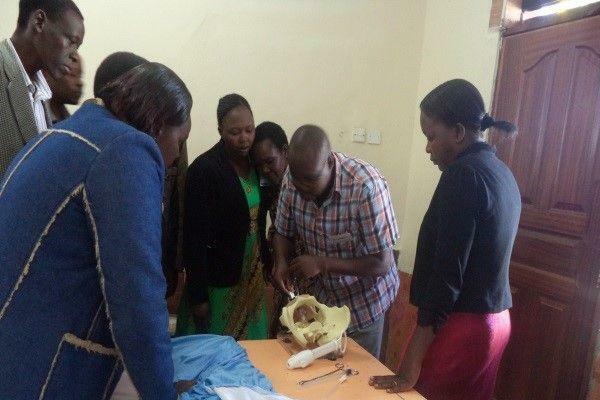
The Making it Happen (MiH) program

What was the MiH Programme?
The Making it Happen (MiH) program was implemented in Kenya in four phases across a period 10 years (2009-2019). Th aim of MiH was to improve maternal and newborn health in Kenya. Working with the Kenyan Ministry of Health (MoH), LSTM delivered capacity development interventions in the area of maternal and newborn health (MNH) and conducted monitoring and evaluation of the effectiveness and impact of these interventions. By 2018 healthcare facilities had been supported in all 47 counties in Kenya.
Working with key stakeholders active in the health sector including the FCDO, United Nations Population Fund (UNFPA), UNICEF and World Health Organization (WHO), the programme achieved tremendous success in improving capacity of the Kenyan health system and its health workforce to improve maternal and newborn health in Kenya.
The key intervention areas the MiH programme included:
- In-service competency-based training in Emergency Obstetric and Newborn Care (EmOC&NC)
- Support to pre-service training
- Supportive supervision
- Quality improvement (QI)
- National Maternal and Perinatal Death Surveillance and Response (MPDSR)
- Monitoring and Evaluation
- Implementation research
Key achievements of MiH programme
In-service competency-based training in Emergency Obstetric and Newborn Care (EmOC&NC):
10,221 healthcare providers, 291 master trainers and 94 Course Directors trained across 47 counties.
Initiated a cost-sharing model where counties are supported to plan and include the participant-related costs of EmoNC capacity building workshops county in their annual work plans and budgets representing a fundamental shift from a model where all costs are covered by the programme, and a critical step towards the sustainability of interventions in these counties.
Support to pre-service training:
Eighteen Midwifery and two Medical Schools supported including capacity building of teaching faculty, strengthening of skills labs and supportive supervision of teaching faculty/clinical instructors.
481 medical interns and 195 midwifery tutors trained in EmOC&NC.
16 pre-service training institutions have received training equipment to equip and support skills labs. Midwifery educators from 20 Kenya Medical Training Colleges trained to improve the quality of ‘skills and drills’ training such as Emergency Obstetric and Newborn Care, in the supported institutions.
Quality improvement (QI):
Over 1,000 participants completed workshops in QI. QI teams were supported to conduct a standards-based audit, and maternal and perinatal death audit, to identify areas for quality improvement, and develop and implement work plans to improve the quality of care.
National Maternal and Perinatal Death Surveillance and Response (MPDSR):
Improved identification of maternal deaths and review of maternal deaths to assess the cause of death and the quality of care.
93 national assessors were trained to conduct maternal death review and apply the ICD-MM.
Technical support for the production of first-ever Confidential Enquiry into Maternal Deaths (CEMD) report for Kenya and implementing the recommendations of the report. This includes support to MoH on policy recommendations (obstetrician cover for maternity units), the introduction of perinatal death reviews, capacity building in caesarean section and perinatal care, capacity building in emergency obstetric care, as well as improving reporting and notification of maternal and perinatal deaths
Support to the establishment and functioning of an MPDSR committee at the county level, including establishing the committee and its secretariat, building assessors’ capacity, and producing county level reports.
Introduction of perinatal death surveillance and review (PNDSR) and standards-based audit (StBA) at the county level
Advocacy through the national MPDSR committee to improve perinatal death review and reporting, and the reorganisation of the maternal and perinatal surveillance system to improve reporting and documentation.
Monitoring and Evaluation:
Routinely collected healthcare facility data and data from programme outputs are aggregated quarterly to inform the logframe indicators where applicable and to monitor progress with programme implementation as well as effectiveness.
MiH established itself as a leading source of high-quality implementation research in the area of Emergency Obstetric Care, Newborn Care, Pre-service training, Maternal Perinatal Death Surveillance and Response, Human resources for health and Quality of care. The research findings continue to contribute to the strong evidence base needed to inform relevant policy at national and county level in Kenya.

Implementation Research sample
Knowledge and skills retention study
Ameh CA, White S, Dickinson F, Mdegela M, Madaj B, van den Broek N. Retention of knowledge and skills after Emergency Obstetric Care training: A multi-country longitudinal study. PLoS ONE 2018 13(10): e0203606. doi: 10.1371/journal.pone.0203606 Available at: https://journals.plos.org/plosone/article?id=10.1371/journal.pone.0203606
Pattinson RC, Bergh AM, Makin J, Pillay Y, Moodley J, Madaj B, Ameh CA, van den Broek N. Obstetrics knowledge and skills training as a catalyst for change. South African Medical Journal 2018;108:748-55. doi: 10.7196/SAMJ.2018.v108i9.13073 Available at: http://www.samj.org.za/index.php/samj/article/view/12399
Maternal Morbidity Study – assessing the burden of disease during and after pregnancy
McCauley M, Madaj B, White SA, Dickinson F, Bar-Zeev S, Aminu M, Godia P, Mittal P, Zafar S, van den Broek N. Burden of physical, psychological and social ill-health during and after pregnancy among women in India, Pakistan, Kenya and Malawi. BMJ Global Health 2018;3(3):e000625. doi: 10.1136/bmjgh-2017-000625 Available at: http://gh.bmj.com/content/3/3/e000625
Stillbirth Study – assessing the cause of and factors associated with stillbirth
Aminu M, Bar-Zeev S, van den Broek N. Cause of and factors associated with stillbirth: a systematic review of classification systems. Acta Obstetricia et Gynecologica Scandinavica 2017;96(2017):519-28. doi: 10.1111/aogs.13126 Available at: http://onlinelibrary.wiley.com/doi/10.1111/aogs.13126/epdf
Halim A, Aminu M, Dewez JE, Biswas A, Fazhar Rahman AKF, van den Broek N. Stillbirth surveillance and review in rural districts in Bangladesh. BMC Pregnancy & Childbirth 2018;18:224. doi: 10.1186/s12884-018-1866-2 Available at: https://bmcpregnancychildbirth.biomedcentral.com/articles/10.1186/s12884-018-1866-2
Social Return on Investment of Emergency Obstetric Care Training
Banke-Thomas AO, Madaj B, Ameh C, van den Broek N. Social Return on Investment (SROI) methodology to account for value for money of public health interventions: a systematic review. BMC Public Health 2015;15:582. doi: 10.1186/s12889-015-1935-7 Available at: http://www.biomedcentral.com/1471-2458/15/582
Banke-Thomas A, Wilson-Jones M, Madaj B, van den Broek N. Economic evaluation of emergency obstetric care training: a systematic review. BMC Pregnancy & Childbirth 2017;17: 403. doi: 10.1186/s12884-017-1586-z Available at: https://bmcpregnancychildbirth.biomedcentral.com/articles/10.1186/s12884-017-1586-z
Banke-Thomas A, Madaj B, van den Broek N. Social Return on Investment of Emergency Obstetric Care Training in Kenya. BMJ Global Health 2018;in press.
Health Systems Governance for Facilities Designated to Provide Comprehensive Emergency Obstetric and Newborn Care in Kenya
Pyone T, Smith H, van den Broek N. Frameworks to assess health systems governance: a systematic review. Health Policy and Planning, 2017;32(5):710-22. doi: 10.1093/heapol/czx007 Available at: https://academic.oup.com/heapol/article/3061529/Frameworks-to-assess-health-systems-governance-a?searchresult=1
Pyone T, Smith H and van den Broek N. Implementation of free maternity services policy and its implication on health systems governance in Kenya. BMJ Global Health 2017;2(4):e000249 doi: 10.1136/bmjgh-2016-00024 Available at: http://gh.bmj.com/content/2/4/e000249
Community Health Workers for Maternal and Newborn Health
Olaniran A, Smith H, Unkels R, Bar-Zeev S, van den Broek N. (2017) Who is a community health worker? – a systematic review of definitions. Global Health Action 2017;10(1):1272223. doi: 10.1080/16549716.2017.1272223 Available at: http://www.tandfonline.com/doi/full/10.1080/16549716.2017.1272223
Factors Influencing Implementation of MPDSR in Kenya
Smith HJ, Ameh CA, Roos N, Mathai M, van den Broek N. Implementing maternal death surveillance and response: a review of lessons from country case studies. BMC Pregnancy & Childbirth 2017;17:233. doi: 10.1186/s12884-017-1405-6 Available at: https://bmcpregnancychildbirth.biomedcentral.com/articles/10.1186/s12884-017-1405-6
Smith H, Ameh CA, Godia P, Maua J, Bartilol K, Amoth P, Mathai M and van den Broek N. Implementing Maternal Death Surveillance and Response in Kenya: Incremental Progress and Lessons Learned. Global Health: Science and Practice 2017;5(3):345. doi: 10.9745/GHSP-D-17-00130 Available at: http://www.ghspjournal.org/content/5/3/345